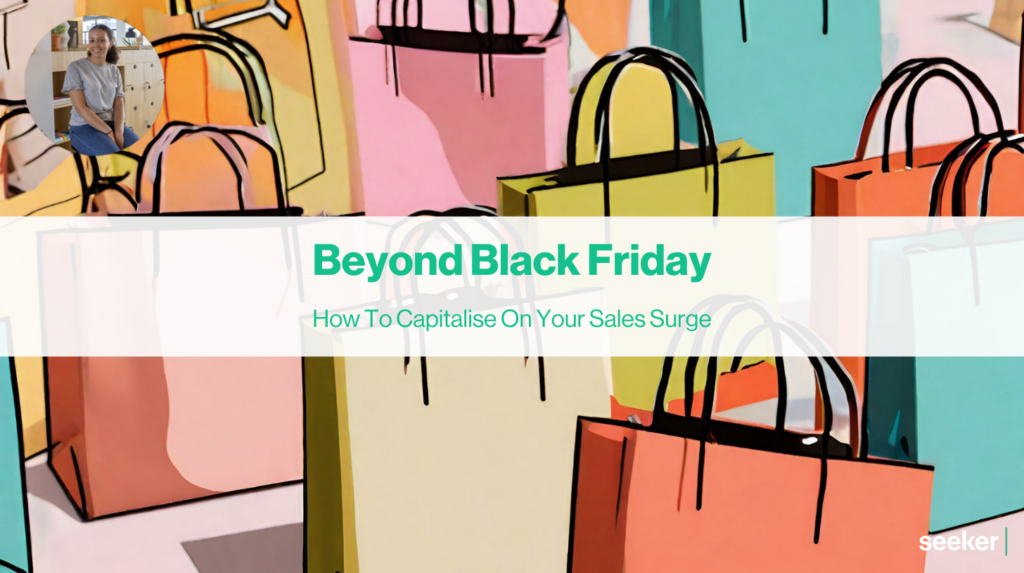
Once Black Friday is over you’ll probably be breathing a sigh of relief. Most of your orders have been dispatched, your marketing campaigns have wound down, and you can start to focus on pushing seasonal sales as Christmas approaches.
But the work doesn’t completely stop there—now is the time to take advantage of all those new leads and give your sales a quick boost.
Read on for a few handy ways to capitalise on your Black Friday sales surge.
How to retain customers after Black Friday
As one of the biggest shopping weekends in the online calendar, a lot of planning goes into making sure you’re maximising your reach during Black Friday. But how do you make sure you’re retaining traffic and customers once the sales have ended?
Here are 6 things you can do to bring customers back after Black Friday.
For tips on How to Create a Christmas SEO Strategy check out our latest blog!
1. Keep your customer service strategy sparkling
Delivering a good customer experience is essential for converting customers into buyers but even more so if you want to retain their custom after Black Friday. Now is the time to focus on customer service.
Think about how you can deliver ongoing support. Your customer relationship management (CRM) tools are essential here: HubSpot, Zoho, Mailchimp, and so on. Shared inboxes are excellent for following-up on threads so customers aren’t left waiting!
It’s also worth creating a set of template replies to queries to speed up response times. Craft some boilerplate copy to quickly use for common questions, and make a list of new queries that crop up this year to inform your strategy for next year.
2. Ensure your returns policy is simple and on-point
Returns are a natural part of ecommerce. Research by Barclaycard found that 30% of shoppers deliberately buy too much, with the aim of returning unwanted products. This is particularly pertinent in terms of Black Friday—with the pressure of time-sensitive deals and perceived scarcity of offers, shoppers are far more likely to buy in bulk and return later.
If your returns policy is too complex, too drawn-out, or just too difficult to use, those new customers you’ve won aren’t likely to shop with you again. While serial returners are a hassle, those customers that continue to buy from you are worth pursuing.
It’s best to keep your returns policy simple. That means making your returns page easy to find and writing easy to follow steps. A good returns policy is a prosaic part of your ecommerce strategy—but an essential one. If it caused problems this year, take steps to ensure any returns for next year’s event go smoothly.
3. Use sales data to suggest targeted products
A great way to prepare your site for Black Friday is optimising your product pages for cross-selling and you can do something similar after the event too. Use sales data to nurture your customers into more than one time purchasers.
For example, if a customer has just bought a single item you could retarget them via email and suggest add-on items and accessories that compliment what they’ve already bought. Or, based on customer personas, suggest other product categories that could be of interest to them.
You don’t want to be too pushy. However, a gentle nudge can be the difference between a customer shopping elsewhere or repurchasing items from you for Christmas!
4. Create helpful gift guides
A great ecommerce SEO hack according to Google’s Helpful Content Update, is to create content for users first, search engines second. In this case, gift guides are the perfect way to re-engage your customers and share content that’s valuable to them which Google loves!
Christmas can be pretty stressful. There’s always one person who’s a nightmare to buy for but providing gift guides can make this decision a little easier and the great thing is, you can create them for all seasonal occasions including Christmas, Valentine’s Day, Mother’s Day and so on!
This can be a great addition to your content marketing strategy. Once you’ve got the guide written you can repurpose it in email marketing, make it into social content and of course post it on your blog! Just make sure you let your customers know about it!
5. Follow up on sales with a tempting coupon code
All those new leads filling up your pipeline are more than just a sale—they’re also a chance to schmooze, seduce, and win over with some tantalising incentives. The best incentives are those that are simple, encourage repeat custom and, ideally, are cost-effective for your business. Enter the humble coupon code.
Coupon codes are great for nurturing post-purchase loyalty. Plus, online coupon users spend 24% more than regular shoppers which means an opportunity for bigger spends per customer! Following your new shoppers’ Black Friday purchases, try sending an email thanking them for their custom, leaving a 7-14 day gap to give them time to receive and use their purchase
This taps into that post-purchase glow and encourages your new shoppers to purchase with you again. Plus, with Christmas hurtling towards us at an alarming rate, these coupons provide an easy solution for their last-minute present-buying woes.
6. Ask for reviews
Reviews are a fantastic and cost-effective way of boosting sales. Whether you choose to collect them on Google Reviews or using an impartial reviewing site, a wealth of positive reviews can be one of the best ways to maintain a healthy ROI.
Following the surge in sales during Black Friday, accumulating reviews from both new and existing customers will sustain the visibility of your products. How does this work? Let’s imagine shoppers are online Christmas shopping for a particular item. As reviews naturally contain long-tail keywords similar to the terms these shoppers are likely to search for, they contribute to improved visibility of the product in search results.
Positive reviews from satisfied customers also provide fresh content, build trust and credibility for your products, reassuring potential buyers about the quality and reliability of what you offer. Better yet, they can also help showcase your best-selling products and highlight the specific benefits and features of the product, easing the buying decision.
The tips above are just a few ideas for giving your Black Friday sales figures a quick and easy boost. If you need a hand with your Black Friday ecommerce strategy for next year, get in touch—we’ve got you covered.
